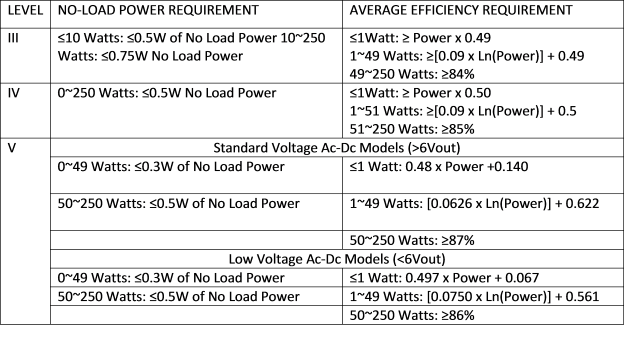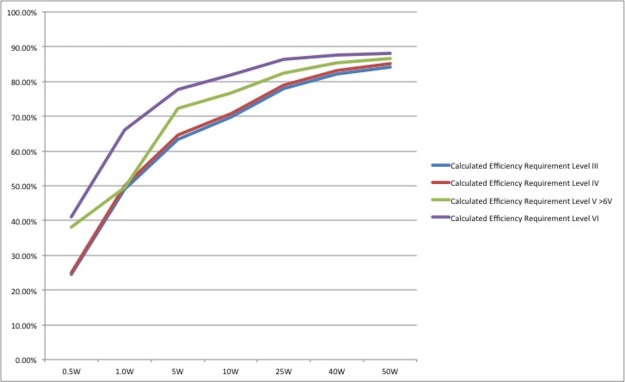BY JEFF SCHNABEL,
VP Global Marketing,
CUI, www.cui.com
The efficiency and no-load power draw of external power supplies and adapters have been the subject of regulation for over a decade. Since the first mandatory standard was implemented in California in 2004, various regulatory bodies have led the way in defining ever-tighter requirements in an effort to reduce global power consumption.
Currently for global compliance, an original equipment manufacturer (OEM) needs an external power supply that meets the Level V standard, which exceeds all previous regional requirements even though it is only enforced within the European Union. However, beginning February 2016, a new set of requirements defined by the U.S. Department of Energy (DOE) will take effect.
While these Level VI standards will be mandatory only in the U.S., any OEM wanting to supply products to the U.S. should be taking action now to ensure compliance.
The birth of efficiency labeling
Changing lifestyles in the developed world have brought large numbers of power adapters — such as those used with notebooks, game consoles, printers, and monitors — onto the grid. By the 1990s, over one billion such devices were estimated to be active in the United States alone.
These power supplies draw considerable power, even under no-load conditions, when the appliance is turned off or disconnected. A 1998 study estimated that this so-called standby power could represent about 5% of total U.S. residential electricity consumption in America, or about $3 billion in wasted energy.
By 2004, national residential electricity consumption had risen to 1.29 billion megawatt-hours (MWh), according to America’s DOE. A 5% loss equates to 64 million MWh, or the equivalent output of 18 typical power stations. There was a clear need for action to curb this waste.
In 2004, the California Energy Commission (CEC) began implementing the world’s first mandatory regulation on the efficiency of external power supplies. Other efficiency standards began to emerge in territories such as China and the European Union. In 2006, Energy Star released the international efficiency marking protocol to harmonize all initiatives around the globe.
The Energy Star protocol calls for manufacturers to identify the efficiency level of each power supply unit using a printed Roman numeral III, IV, V, or VI on the label, as shown in Fig. 1 .

Fig. 1: Efficiency marking in accordance with International Energy Efficiency Marking Protocol for External Power Supplies.
The marking protocols impose constraints on both dynamic and no-load performance. A maximum no-load power limit is typically specified, while dynamic performance is defined according to minimum average efficiency levels. Table 1 summarizes the no-load and average efficiency specifications set out in Levels III, IV, and V.

Note: The term “power” means power stated on the power supply label.
Table 1: Summary of marking protocol thresholds, Levels III to V.
Between 2008 and 2012, the U.S. Energy Independence and Security Act (EISA) standard, the European ErP regulations, and voluntary frameworks such as the Australian Minimum Equipment Performance (MEP) and Natural Resources Canada (NRCan) adopted the international marking protocol Level IV specifications. In 2011, however, the EU announced that it would make the tougher Level V standards mandatory. This remained the position, with the EU at Level V and the U.S. and other territories at Level IV, until 2014.
The move to Level VI
In February 2014, the U.S. DOE announced that products to be marketed in the U.S. would have to comply with the Level VI standard by Feb. 10, 2016. Any external power supply manufactured after this date and shipped into the U.S. must meet the new efficiency targets. Fig. 2 shows how the latest standards place increasing demands on average efficiency.

Fig. 2. Comparison of average efficiency thresholds for marking protocols Level III to Level VI.
Level VI scope and structure
The Level VI protocol is significantly more complex than its predecessors. Several categories are defined, and new classifications will be regulated for the first time, including multiple-voltage power supplies and single-voltage power supplies over 250 W. Fig. 2 shows only the first category in the Level VI framework, which is for Single-Voltage External AC/DC Power Supplies. These are defined as basic-voltage external power supplies that are designed to convert line-voltage AC into lower-voltage DC output and are able to convert to only one DC output voltage at a time.
Level VI defines four other power supply categories:
- Single-Voltage External AC/AC Power Supplies (basic voltage)
- Single-Voltage External AC/DC Power Supplies (low voltage)
- Single-Voltage External AC/AC Power Supplies (low voltage)
- Multiple-Voltage External Power Supplies up to 49 W
Low-voltage power supplies have an output voltage of less than 6 V and an output current greater than 550 mA. Basic voltage refers to a power supply that is not a low-voltage power supply.
Table 2 summarizes the specifications for all categories included in Level VI.

Table 2: Summary of no-load and average efficiency targets for Level VI marking protocol.
Distinctions and exemptions
The Level VI standard distinguishes between power supplies for direct operation and indirect operation, and applies only to units intended for direct operation. These are external power supplies that can function in the end product without a battery. An indirect power supply is not a battery charger but cannot operate the end product without the assistance of a battery.
Some classes of direct power supplies are exempt. These include devices that require FDA approval, such as a medical device in accordance with section 360c of title 21, and AC/DC power supplies with a nameplate output voltage less than 3 V and a nameplate output current greater than or equal to 1,000 mA that charges the battery of a product that is fully or primarily motor-operated.
Financial and environmental benefits
The EPA estimates that external power supply efficiency regulations implemented over the past decade have reduced energy consumption by 32 billion kW, saving $2.5 billion annually and reducing CO2 emissions by more than 24 million tons per year.
According to estimates by the U.S. DOE[1] , the move from mandatory Level IV to Level VI will save about 47 million tons of CO2 emissions. The DOE also suggests that, by 2030, Level VI power supplies could deliver annual energy savings of about 8.9 million MW hours, equivalent to 0.15% of the 5.9 billion MW hours of total residential energy use in 2012[2] .
CUI began introducing Level VI-compliant adapters in late 2014 to address the coming regulation. Now that the trend toward increasingly energy-efficient power supplies is firmly entrenched, many OEMs are seeking efficiencies even higher than the mandatory levels as a way to differentiate their end products. CUI is working with its customers to implement advanced energy-saving technologies to satisfy current market demands and work toward compliance with future regulations.
New Level VI regulations will cause OEMs globally to specify Level VI-compliant adapters for future products, and suitable adapters are already entering the market. If historical trends are any indication, it is expected that the European Union, Canada, and Australia will soon follow suit with similar regulations. The time to begin preparing for Level VI compliance is now.
For more information, visit www.cui.com/efficiencystandards.
References:
[1] Energy Conservation Program: Energy Conservation Standards for External Power Supplies: http://www.energy.gov/sites/prod/files/2014/02/f7/eps_ecs_final_rule.pdf
[2] Total residential energy use in 2012 was 20.195 quads: http://www.eia.gov/totalenergy/data/monthly/?src=Total-f3#consumption
Advertisement
Learn more about CUI Inc





